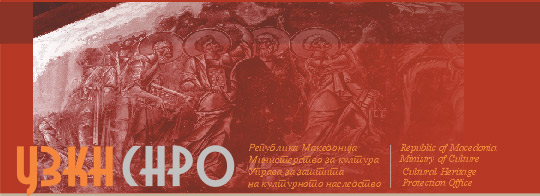VISIT OF THE EXHIBITION BYZANTIUM 330-1453
IN THE ROYAL ACADEMY OF ARTS, LONDON , GREAT BRITAIN

 On 25 October 2008, at the Royal Academy of Arts in London , Great Britain was opened a great exhibition dedicated by Byzantine art, called Byzantium 330-1453. This is the first exhibition of such a large scale dedicated to the artistic achievements of the Byzantine Empire, presented in Great Britain in the past 50 years. It features more than 300 exhibits (some of the works have never been displayed in public before), including icons, frescos, mosaics, manuscripts, ivories, enamels, jewellery, as well as gold and silver metalwork. On 25 October 2008, at the Royal Academy of Arts in London , Great Britain was opened a great exhibition dedicated by Byzantine art, called Byzantium 330-1453. This is the first exhibition of such a large scale dedicated to the artistic achievements of the Byzantine Empire, presented in Great Britain in the past 50 years. It features more than 300 exhibits (some of the works have never been displayed in public before), including icons, frescos, mosaics, manuscripts, ivories, enamels, jewellery, as well as gold and silver metalwork.
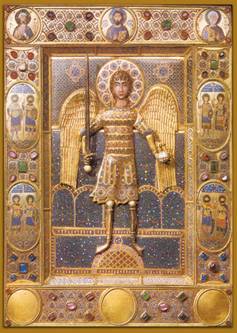  The exhibition Byzantium 330–1453 is organized by the Royal Academy of Arts from London and the Benaki Museum from Athens , under the patronage of the Prince of Wales. Professors Robin Cormack from the Courtauld Institute and Maria Vassilaki from the University of Thessaly from Volos and the Benaki Museum, and Dr. Adrian Locke, Head of exhibitions at the Royal Academy of Arts are the exhibition curators. As Sir Nicholas Grimshaw, the President of the Royal Academy of Arts, says himself, this is one of the most ambitious and most complex exhibitions ever organized by this institution. The exhibition Byzantium 330–1453 is organized by the Royal Academy of Arts from London and the Benaki Museum from Athens , under the patronage of the Prince of Wales. Professors Robin Cormack from the Courtauld Institute and Maria Vassilaki from the University of Thessaly from Volos and the Benaki Museum, and Dr. Adrian Locke, Head of exhibitions at the Royal Academy of Arts are the exhibition curators. As Sir Nicholas Grimshaw, the President of the Royal Academy of Arts, says himself, this is one of the most ambitious and most complex exhibitions ever organized by this institution.
 The exhibition is conceptualized as a chronological journey, starting with the founding of Constantinople in 330 AD by Constantine the Great and concludes with the capture of the city by the Ottoman forces of Mehmed II in 1453. It follows the chronological progression covering the range, power and longevity of the artistic production of the Byzantine Empire through a number of themed sections. In this way the exhibition explores the origins of Byzantium, the rise of Constantinople, the threat of iconoclasm for Christian figurative art, the remarkable crescendo in the Middle Ages, the close connections between Byzantine and early Renaissance art in Italy in the 13 th and 14 th centuries, until the very end of the Byzantine Empire marked with the fall of Constantinople in 1453. The exhibition is conceptualized as a chronological journey, starting with the founding of Constantinople in 330 AD by Constantine the Great and concludes with the capture of the city by the Ottoman forces of Mehmed II in 1453. It follows the chronological progression covering the range, power and longevity of the artistic production of the Byzantine Empire through a number of themed sections. In this way the exhibition explores the origins of Byzantium, the rise of Constantinople, the threat of iconoclasm for Christian figurative art, the remarkable crescendo in the Middle Ages, the close connections between Byzantine and early Renaissance art in Italy in the 13 th and 14 th centuries, until the very end of the Byzantine Empire marked with the fall of Constantinople in 1453.
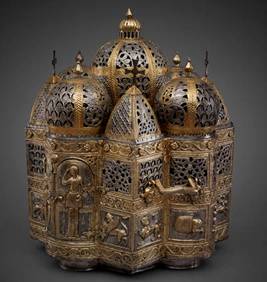  Byzantium 330-1453 showcases works and rare items from collections, museums and monasteries across Europe (from the San Marco Treasury in Venice, the national museums from Belgrade, Bucharest, Sofia, Nicosia, Athens, Berlin, Moscow, Kiev, from the Louvre, the Byzantine Museum in Thessaloniki, the British Museum, the libraries of Oxford, Cambridge, Venice, Paris, Vatican etc.), as well as from USA (Metropolitan- New York, Cleveland, Boston etc.), Armenia, Egypt (the icons from St. Catherine monastery at Sinai were presented as replicas, expecting the arrival of the originals). Byzantium 330-1453 showcases works and rare items from collections, museums and monasteries across Europe (from the San Marco Treasury in Venice, the national museums from Belgrade, Bucharest, Sofia, Nicosia, Athens, Berlin, Moscow, Kiev, from the Louvre, the Byzantine Museum in Thessaloniki, the British Museum, the libraries of Oxford, Cambridge, Venice, Paris, Vatican etc.), as well as from USA (Metropolitan- New York, Cleveland, Boston etc.), Armenia, Egypt (the icons from St. Catherine monastery at Sinai were presented as replicas, expecting the arrival of the originals).
 At a prominent place at the exhibition were the eight icons from the Republic of Macedonia, from the Ohrid Icon Gallery: the Archangel Michael from the Annunciation (beginning of 12 th century); the Virgin of the Annunciation (beginning of 12 th century); The Baptism of Christ (beginning of 14 th century); The Anastasis (beginning of 14 th century); Doubting Thomas (beginning of 14 th century); the liturgical icon of the Virgin Psychosostria/ Annunciation (beginning of 14 th century); Christ Pantokrator (mid 14 th century) and Virgin Psychosostria (mid 14 th century). They are exhibited in a separate hall and stand out as being among the most valuable and the most attractive works at this exhibition . At a prominent place at the exhibition were the eight icons from the Republic of Macedonia, from the Ohrid Icon Gallery: the Archangel Michael from the Annunciation (beginning of 12 th century); the Virgin of the Annunciation (beginning of 12 th century); The Baptism of Christ (beginning of 14 th century); The Anastasis (beginning of 14 th century); Doubting Thomas (beginning of 14 th century); the liturgical icon of the Virgin Psychosostria/ Annunciation (beginning of 14 th century); Christ Pantokrator (mid 14 th century) and Virgin Psychosostria (mid 14 th century). They are exhibited in a separate hall and stand out as being among the most valuable and the most attractive works at this exhibition .
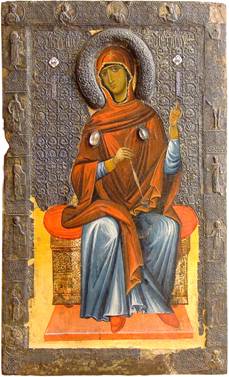 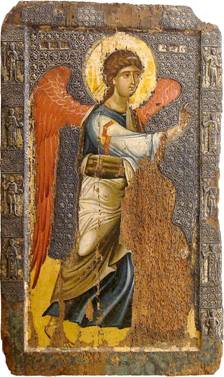
 Among the rare items presented at this exhibition is the Antioch chalice, dated in 500-550 AD, on loan from Metropolitan museum – New York , believed to have been the Holy Grail upon its discovery in 1911. Among the major works from the Treasury of San Marco is the ornate Chalice of the Patriarchs, c. 10 th -11 th century; than the imperial ivory casket from Troyes cathedral depicting hunting scenes, but also rare manuscripts as the Homilies of Monk James Kokkinobaphos of 1100-1150 AD, on loan from Bibliotheque Among the rare items presented at this exhibition is the Antioch chalice, dated in 500-550 AD, on loan from Metropolitan museum – New York , believed to have been the Holy Grail upon its discovery in 1911. Among the major works from the Treasury of San Marco is the ornate Chalice of the Patriarchs, c. 10 th -11 th century; than the imperial ivory casket from Troyes cathedral depicting hunting scenes, but also rare manuscripts as the Homilies of Monk James Kokkinobaphos of 1100-1150 AD, on loan from Bibliotheque 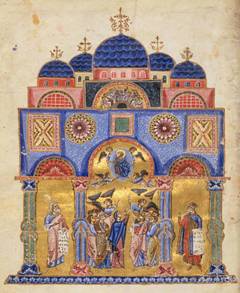 Nationale de France, Paris; the Hludov Psalter (9 th century) from the National Historical museum from Moscow etc. Nationale de France, Paris; the Hludov Psalter (9 th century) from the National Historical museum from Moscow etc.
 As supplementary activities to the exhibition, the Royal Academy of Arts organizes a series of lectures and workshops on different topics of Byzantine history and art for the wider public. These events, as well as the extraordinary turnout of the exhibition, will contribute to the increasing of the interest and popularization of the art of Byzantium . As a crucial part of the exhibition, certainly the icons from the Republic of Macedonia will profit of the extraordinary opportunity to be seen by thousands of visitors, thus illustrating the rich and unique cultural heritage of our country. As supplementary activities to the exhibition, the Royal Academy of Arts organizes a series of lectures and workshops on different topics of Byzantine history and art for the wider public. These events, as well as the extraordinary turnout of the exhibition, will contribute to the increasing of the interest and popularization of the art of Byzantium . As a crucial part of the exhibition, certainly the icons from the Republic of Macedonia will profit of the extraordinary opportunity to be seen by thousands of visitors, thus illustrating the rich and unique cultural heritage of our country.
 Kristina Biceva MA, Advisor on Cultural and Historical Heritage, visited the exhibition as a representative of the Cultural Heritage Protection Office, together with Tanja Paskali Buntasheska, Director of NI Institute for Protection of Monuments of Culture and Museum – Ohrid. Kristina Biceva MA, Advisor on Cultural and Historical Heritage, visited the exhibition as a representative of the Cultural Heritage Protection Office, together with Tanja Paskali Buntasheska, Director of NI Institute for Protection of Monuments of Culture and Museum – Ohrid.
The exhibition will be open until 22 March 2009.
|
